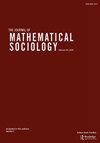漂移到顶端?影响流行音乐翻唱率的纠缠机制
IF 0.7
4区 社会学
Q3 MATHEMATICS, INTERDISCIPLINARY APPLICATIONS
引用次数: 0
摘要
摘要:是什么导致了公告牌排行榜上的营业额?文化进化的中性模型假设品味是通过无偏见的复制过程传播的,它提供了关于受欢迎程度排名列表中预期受欢迎程度分布和营业额的精确预测。这一领域的最新进展使得通过研究观察到的更替率与中性模型预测的偏差来表征音乐品味传播机制的可能性成为可能。在这里,我偏向中性模型来研究个人音乐品味传播的四个替代概念(歌曲质量、个人地位、社交网络和反信息主义者),并使用基于代理的模拟来检验对营业额的影响。然后,我将1958年至2021年期间Billboard Hot 100的建模营业额数据与实证营业额数据进行了比较,发现观察到的营业额模式仅在模拟对最受欢迎歌曲的系统拒绝的反信息主义模型中再现。这一发现出乎意料,并挑战了普遍“偏爱大众”的概念。总的来说,这项研究有助于就品味传递机制和时尚变化机制进行持续的辩论。本文章由计算机程序翻译,如有差异,请以英文原文为准。
Drifting to the top? Disentangling mechanisms influencing the turnover rate of popular music
ABSTRACT What causes turnover on the Billboard charts? The neutral model of cultural evolution, which assumes that taste is transmitted via an unbiased copying process, provides precise predictions regarding expected popularity distributions and turnover within a popularity-ranked list. Recent advances in this line make it possible to characterize the likelihood of music taste transmission mechanisms by investigating departures of observed turnover rates from neutral model predictions. Here, I bias the neutral model to investigate four alternative conceptions of individual music taste transmission (song quality, individual status, social network, and anticonformist) and use agent-based simulations to examine the impact on turnover. I then compare modeled with empirical turnover data from the Billboard Hot 100 over the period from 1958 to 2021 and find that observed turnover patterns are reproduced only in an anticonformist model simulating the systematic rejection of the most popular songs. This finding was unexpected and challenges the notion of a generalized “preference for the popular.” Overall, this study contributes to ongoing debates regarding the mechanisms involved in the transmission of taste and the mechanics of fashion change.
求助全文
通过发布文献求助,成功后即可免费获取论文全文。
去求助
来源期刊

Journal of Mathematical Sociology
数学-数学跨学科应用
CiteScore
2.90
自引率
10.00%
发文量
5
审稿时长
>12 weeks
期刊介绍:
The goal of the Journal of Mathematical Sociology is to publish models and mathematical techniques that would likely be useful to professional sociologists. The Journal also welcomes papers of mutual interest to social scientists and other social and behavioral scientists, as well as papers by non-social scientists that may encourage fruitful connections between sociology and other disciplines. Reviews of new or developing areas of mathematics and mathematical modeling that may have significant applications in sociology will also be considered.
The Journal of Mathematical Sociology is published in association with the International Network for Social Network Analysis, the Japanese Association for Mathematical Sociology, the Mathematical Sociology Section of the American Sociological Association, and the Methodology Section of the American Sociological Association.
 求助内容:
求助内容: 应助结果提醒方式:
应助结果提醒方式:


